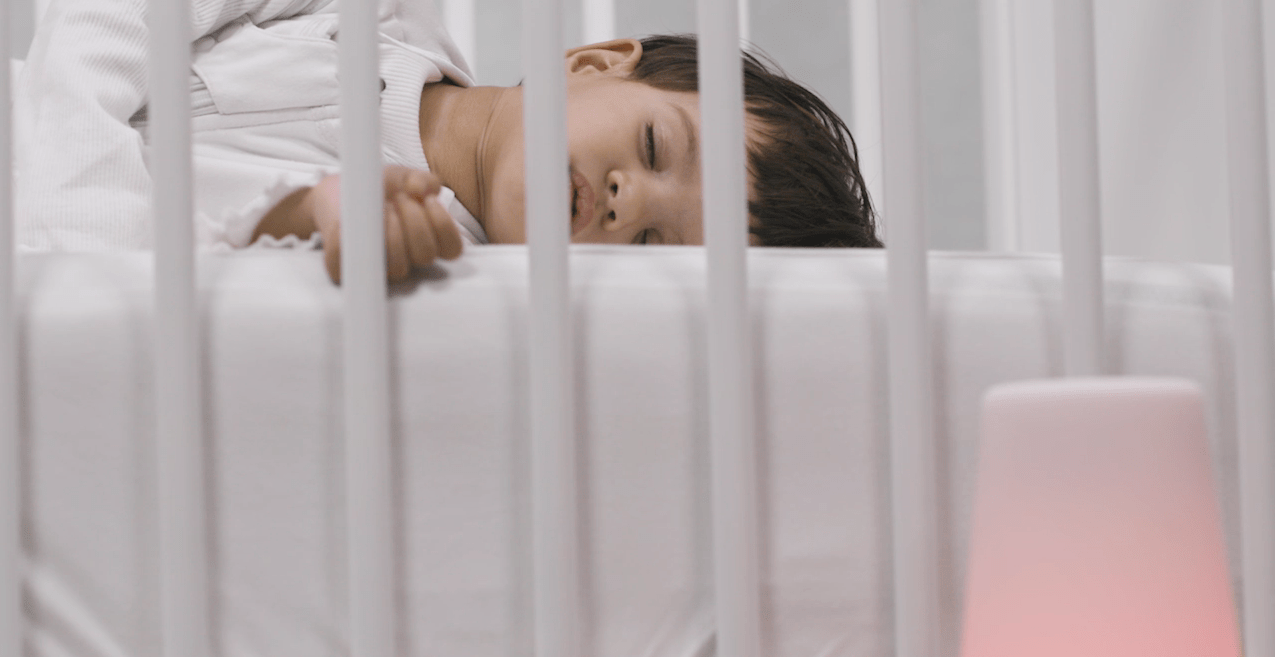
“I feel like it’s the opposite of ‘Cry-It-Out’”
Hayes fell ill leading to a cycle of co-sleeping. Once he recovered, this reliance seemed to prevent a smooth transition…

Batelle’s Chief Operating Officer, Gigi Brett, explains how solving parental sleep deprivation for working mothers can have outsized effects on retaining senior female employees.
The reason I feel this pressure is that I know I want to have children one day. I also know that unless my partner and I take preemptive measures to prolong having kids (like freezing eggs for example), that there is a biological timelimit on this. So rightly or wrongly, the question of having children has always felt like a question of trade-offs to me. One big trade-off is travel. I very much still have the urge to explore this planet. But I do understand that having a little being that depends on your for their survival, limits the ability to jet off to weird and wonderful places on a whim.
The other trade-off, which I think is much more pervasive, is career. For a lot of my working life, I have felt like there is a very real dilemma when it comes to this question. As a woman, statistically I’m likely to shoulder 2-3 times more of the childcare burden than my husband would (yes, these stats are from 2021 and 2022 data). I have to admit, I am lucky to have found one of the most supremely supportive partners, so the odds are stacked in my favor here. However, the data shows that attrition among women who don’t return to work after having kids – especially senior women – is still much higher than our male counterparts. Not only is this detrimental for companies who lose senior talent, but for the women themselves I think this can come at a huge personal cost. It certainly has felt like that to me. I’m therefore really proud of the work we have done at Batelle. We have built a company that helps preempt and solve one of the biggest reasons for needing to make trade-offs in the first place: lack of sleep. Below is a more comprehensive discussion, which I hope will give a few of you a reason to sleep better at night.
“Ultimately, what companies are doing is giving women a way to avoid falling pregant during their peak career-building years.“
Companies pour enormous amounts of money into retaining top talent, especially around the topic if childcare. Despite these efforts, attrition rates after childbirth remain highest among the most senior women at companies. There are two main reasons for this; firstly lack of suitable childcare options and secondly from burnout. Solving the issue of children’s sleep, is the cheapest intervention a company can make to ease the childcare burden and address the biggest cause of burnout.
Many companies have gone to extreme lengths to retain female talent. Generous maternity leave is one; provision of childcare being another. However, more and more companies have introduced another type of benefit: fertility treatments. This takes many forms, from freezing of eggs, to surrogacy, adoption, to IVF. These measures are not only incredibly expensive, but are often seen as self-serving. Ultimately, what companies are doing is giving women a way to avoid falling pregant during their peak career-building years. While this benefit has great uptake, not all women opt to prolong starting a family, and companies are being forced into an uncomfortable position of either being seen as pro-career or pro-family.
The reason companies are pouring billions into both childcare and fertility benefits is one of economics. According to the US Chamber of Commerce, one million women are missing from the labor force in the US compared to pre-pandemic. Men have mostly returned to work. In the same study it shows that 58% of parents leaving the workforce cited “unable to find childcare solutions that meet needs” as the primary reason for their departure. This problem is even more severe than at first glance. If you look at this data in relation to the seniority of women employees who left a position after having children, it raises quite dramatically:
| TITLE | WOMEN WHO DIDN’T RETURN TO WORK POST-PARTUM |
|---|---|
|
EMPLOYEE
|
23%
|
|
MANAGER OF EMPLOYEES
|
44%
|
|
MANAGER OF MANAGERS
|
53%
|
|
SENIOR LEADERS
|
61%
|
What this means is that businesses are not just losing female talent, they are disproportionately losing their most senior women.
Let’s dig a bit deeper into the root causes of this attrition; childcare and burnout. Although these two issues appear distinct on first glance, it’s the combination that is most interesting, and most costly.
Having children is a big undertaking, especially for women. According to the Center for Global Development, if you are a mom, you are likely to take between twice and three times as much of the childcare burden as a dad would. Since the pandemic, this statistic sits closer to 3x.
There is also increasing instances of women feeling burnt out. According to the US Chamber of Commerce, 1 in 3 women considered leaving or changing careers due to burnout in 2021, up from 1 in 4 in 2020. If we look into the biggest predictor of on-the-job-burnout, we see that there is overlap with a significant pain point for new parents: sleep.
According to the National Sleep Foundation, “sleeping less than six hours each night is one of the best predictors of on-the-job burnout”. This lack of sleep may be due to high pressure jobs that require 16 hour days – or – having children… According to research, on average, a new parent loses 109 minutes of sleep every night for the first year after having a baby. That’s 646 hours a year.
With women then taking 2-3 times more of the childcare burnen, the “sleep issue” falls primarily on them. We see this validated daily when speaking with parents who come to us for help. Durning the first few months of life, certain sleep habits and associations are formed and children anchor to certain “conditions” of sleep. Because about 80% of new mothers breastfeed their babies (something dad can’t help with), coupled with the fact that babies often feed to sleep, they often begin to associate mom with sleep.
This means that mothers are often the only ones who can put their baby to sleep. Dad, grandparents or even a nanny are rendered obsolete when it comes to getting a child down for a nap, bedtime or one of the often multiple night wakings. This reliance means that moms are exhausted, spending hours on getting thier child to sleep, and on top of that trying to figure out how they are going to balance going back to work. The more senior the job, the more demanding and pressured the role. The higher the expectations, the more daunting it feels to balance motherhood and careeer. It is unsurprising then that the more senior a woman is, the less likely she is to return to work after childbirth. It just becomes too much. If you want an insightly rediction on this trade-off, watch Shonda Rhyme’s 2014 Dartmouth Ceremony’s articulation start at 17:19:00 https://www.youtube.com/watch?v=EuHQ6TH60_I.
Luckily for both sleep deprived parents and thier employers, sleep is a very solable problem. It comes down to understanding the science of sleep and associations. There are two approaches: prevention and cure. According to the American Family Physician Journal, up to 50% of children experience a sleep problem. These issues can easily be prevented by educating parents on the common pitfalls and best practise. In fact, the vast majority of sleep issues arise from reinforcing associations that create the prorblem in the first place. If you want to take the preventive path, the window to do so is from pregnancy to about 5 months of age.
If a sleep issue has already arisen, then it becomes a question of how to correct the sleep associations. Most pediatricians recommend working with a child from about 4 months upwards, we prefer to wait until 6 months. Depending on the solution you use, this could be applicable all the way through until a child is 7 years old (yes, some parents have had seven years of sleep depravation).
Creating good sleep habits makes a lot of sense both for the parent, but also the employer. It costs $1500 to fully solve the probelm. While that may feel like a significant investment for an individual, it is by far the cheapest investment a company can make in thier new or expecting parents. Not only will solving this problem help retain female talent, but it will also mean that all new parents are better rested, less overwhelmed and more able to be productive in both parenting and career.
“Most pediatricians recommend working with a child from about 4 months upwards, we prefer to wait until 6 months.”
The question of having children has always felt like a question of trade-offs to me, with the big ones being travelling and career. Over the last few years, my husband and I taken full advantage of being able to work from anywhere, with stints in London, Norway, Portugal, Montenegro, Bali and now back to South Africa. Travelling feels like freedom to me, something that would be curtailed dramatically by starting a family. The other big trade-off, which I think is much more pervasive, is career. As a woman, statistically I’m likely to have 2-3 times more of the childcare burden than my husband would. I have to admit, I am lucky to have one of the most supremely supportive partners, so the odds are stacked in my favor here. However, most women feel like they have a very real tradeoff to make when it comes to this question. Sadly, the data shows this becomes more acute the more senior a woman gets. Not only is this detrimental for companies who see higher attrition rates among their most senior employees, but for the women themselves I think this can come at a huge personal cost. I’m therefore really proud that we have been able to build a company that can help women not have to make these tradeoffs between career and children. A solution that can preempt a lot of these really difficult issues in the early years of having a child. Below is a more comprehensive discussion, which I hope will give a few of you women out there some peace of mind.

Hayes fell ill leading to a cycle of co-sleeping. Once he recovered, this reliance seemed to prevent a smooth transition…

Andrea and Nate were skeptical about the Batelle Babies program but decided to give it a go to help Ian…

After trying ‘Cry-It-Out’ unsuccessfully, Jamie was looking for a gentle method to support her son and his sensory processing disorder….
